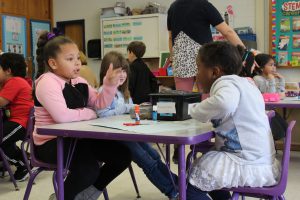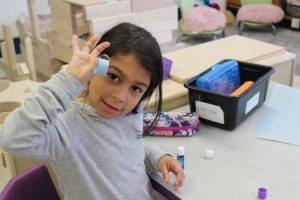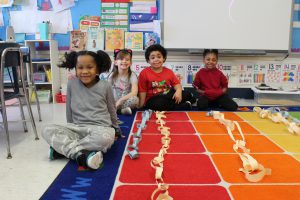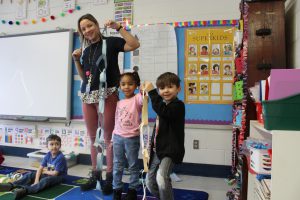
The first day that George L. Cooke Elementary School kindergarten students Brielle Maynor and Gabriel Perez-Rodriguez competed in their class’s paper chain challenge, their chain was too short. The next day, it was long enough to claim the grand prize.
It was all a part of a hands-on lesson in teacher Brianne Liebman’s classroom on the engineering design process: Ask, Improve, Imagine, Create and Plan. On the first day, students were divided into teams and tasked with using the process to create the longest paper chain they could.

On the following day, the teams got back together to discuss their paper chain strategies – what had worked and what hadn’t – and worked together to brainstorm how they could improve and lengthen their chain. Teammates who disagreed on strategy had to discuss pros and cons with each other, ultimately coming to a collaborative agreement.

After the teams decided on strategy, it was time to put their plan into action, with each team member actively participating. As problems arose, they work together to solve them. One team had planned on making each individual chain link wide and thick, but after it didn’t seem to be doing much to create length, the team instead switched gears, cutting out longer, thinner strips.
Once all the groups are completed, the students come together to discuss what they did differently from the previously day and whether it helped or hindered the length. One student mentioned that his technique had worked to elongate the chain, but that his team did not have sufficient time to make enough links to move the needle. Ms. Liebman points out that all teams had the same amount of time. The team reassesses amongst themselves for a few minutes before the same boy says, “We spent too much of our time talking, and not enough time actually making the chain. Next time, we’ll spend more of our time working and less talking.”

Meanwhile, Brielle and Gabriel admired their chain, which was longer than any other chain in the room.
“We cut longer strips this time so that each link is bigger,” Gabirel said.
“Yeah, yesterday we made them too small,” Brielle added.
As Ms. Liebman handed out the grand prize of a book to Gabriel and Brielle, and a consolation prize on an M&M and a sticker to the remainder of the children, she explained how scientists constantly try new approaches and are always trying to improve outcomes.
“I’m proud of all of you,” she said. “You all tried hard, worked together and did your best. Always remember to never stop trying new things.”
